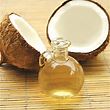Coconut Oil





-
COCONUT OIL
- LATIN NAME:
- Cocos nucifera L
- Family: Palmae
- ETYMOLOGY
Cocos is Portuguese for monkey, as it was thought that the nut resembled a monkey's face.
Nucifera means bearing nuts.- THE PLANT AND ITS ENVIRONMENT
The palm tree grows to about 25 metres (80 feet) and is of great commercial significance. The origin of the coconut is unknown, but it is believed to have spread from the Indian Ocean to Malaysia and Polynesia. - The outer fibres of the coconut are impervious to salt water and when fruits from plants growing at the water's edge dropped into the sea they were taken by currents and tides throughout the South Sea Islands.
- Now, because of its economic importance, the coconut is cultivated in many tropical areas, especially Africa and South East Asia.
- The fruit is a large drupe with a hard endocarp and fibrous pericap, the seed and its endocarp making up the commercial coconut. The seed albumin consists of the 'milk' and a solid - the copra, which contains 65% lipids (Bruneton 1995)
- The tree, when fully grown at 30 years, will yield about 80 nuts a year, although it is reputed that some varieties can produce up to 200 nuts per year in bunches of 10-20. The extremely long leaves (up to 4-5 metres or 13-16 feet) grow only at the top and so the trunk is ringed with the previous years leaf scars.
- He who sees a straight coconut palm will go direct to heaven. Indian Saying.
- THE OIL
Coconut oil is a solid being a white, crystalline, highly saturated fat which melts at about 25C, having a distinctive, easily recognised odour. It is stable when exposed to the air. - When solid coconut oil is fractionated a clear liquid oil results.
- It is the fractionated oil which is commercially available but it is not a complete oil and its use in aromatherapy may therefore be questioned.
- Fractionated and purified endosperm oil of coconut (Thin vegetable oil of the BPC) contains triglycerides containing only short and medium chain length fatty acids (eg octanoic, decanoic); it has low viscosity and solidifies at 0C (Trease & Evans 1983)





- METHOD OF EXTRACTION
- Coconut oil can be obtained by cold pressing, the flesh found inside the shell of the coconut, but is often solvent extracted.
- PRINCIPAL CONSTITUENTS
| Typical fatty acid unit content | 85.2% |
| Typical monounsaturated fatty acid unit content | 6.9% |
| Typical polyunsaturated fatty acid unit content | 1.7% |
- Coconut oil can be obtained by cold pressing, the flesh found inside the shell of the coconut, but is often solvent extracted.
- Glycerides: trimyristin, trimyristin, trilaurin, triolein, tristearin, tripalmitin also the glycerides of caprylic, capric and caproic acids.
- Reference: Carrier Oils for Aromatherapy : Len Price with Ian Smith & Shirley Price
- Coconut Oil Continued - Coconut - 2
Articles-Most Read
- Home
- Contact Us
- Coconut Oil-2
- Absorption Ratings for Carrier Oils
- Cold Pressing Method
- What are Essential Fatty Acids
- Cherry Kernel Oil
- Fixed Oils and Skin Penetration
- Hempseed Oil
- Almond Oil
- Cocoa butter
- Camelina Oil
- Antibacterial Effects Of Carrier Oil
- Coconut Oil
- Lime Blossom Oil (macerated)
- Carrot Oil, Wild Carrot Oil (macerated)
- Apricot Kernel Oil
- Kukui Nut Oil
- Jojoba Wax
- Pumkin Seed Oil - Cucurbita maxima, C. pepo
- Passion Flower OIl (Macerated)
- Hydrocotyle Oil (macerated)
- Palm Kernel Oil
- Rapeseed Oil - Carrier Oil
- Nutrients
Who's On Line
We have 66 guests and no members online
Articles-Latest
- How to Make Homemade Olive Oil: A Step-by-Step Guide
- 20 Evidence-Based Aloe Vera Oil Benefits For Skin, Hair & Health
- Peanut oil - Cold pressed - Are There Health Benefits? How To Make
- What Are the Health Benefits of Black Seed Oil?
- Comfrey oil Infused
- Chamomile Flowers Infused Oil
- Calendula Flowers Infused Oil
- Arnica Flowers Infused Oil
- How To Make Herb-Infused Oils
- DIY avocado oil for healthy skin
- How To Make Coconut Oil
- 8 Benefits of Mustard Oil, Plus How to Use It
- SHOREA STENOPTERA SEED BUTTER
- Shea Butter- 7 Amazing Benefits Of Shea Butter
- Monoi Oil For Hair & Skin
- Mango Seed Oil
- Cohune Oil Is The Next Big Thing
- Brazil Nut OIl
- 7 Impressive Benefits Of Allspice
- Camelina Oil Benefits, Uses, and Side Effects




